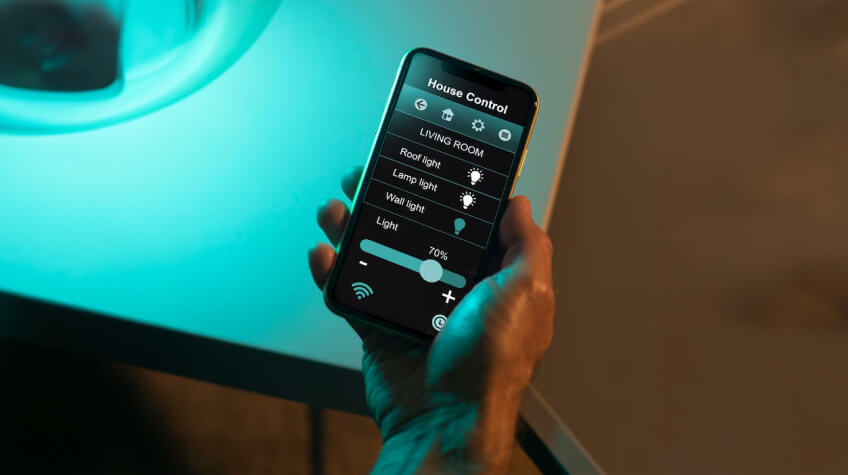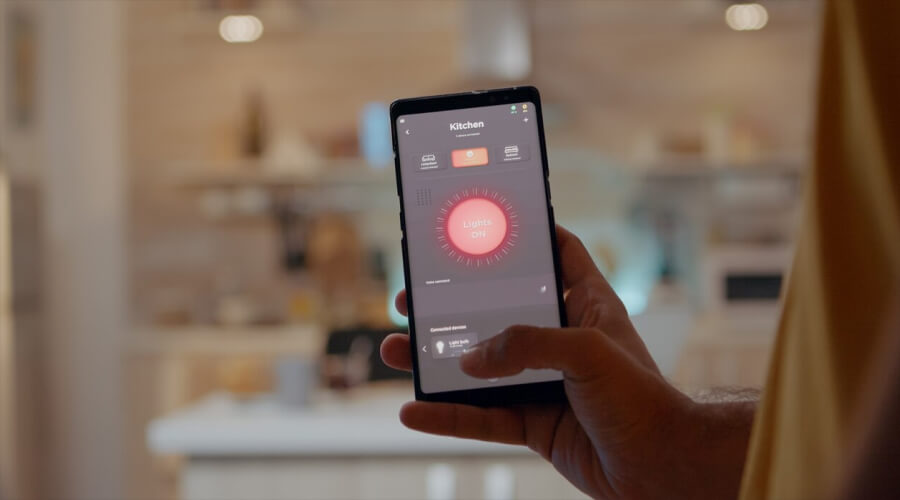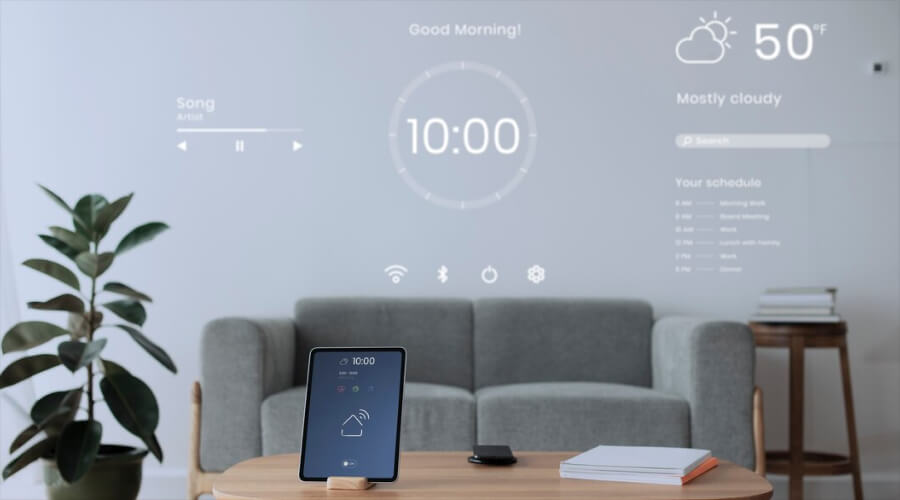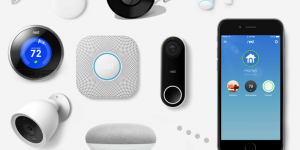
Creating a smart home app means combining state-of-the-art technologies to improve contemporary living areas’ efficiency, security, and comfort. Through the use of these applications, consumers may remotely manage and automate their homes using smartphones or tablets and a variety of gadgets. Smart home applications provide individualized experiences and simplify everyday tasks from controlling room temperatures to keeping an eye on security cameras and controlling energy use.
The difficulty is combining several hardware and software parts smoothly while prioritizing strong security measures and user-friendly interfaces. Smart home software has to be innovative, well-planned, and deeply aware of user demands as the need for connected living increases.
What is Smart Home Automation App?
Software intended to automate and control home appliances and systems is called a smart home automation app. Users with a smartphone or tablet may remotely control appliances, security systems, lights, and heating using an intuitive interface.
Customized timetables, real-time monitoring, and energy management are made possible by these applications, which also facilitate the smooth integration of many smart home devices. These applications increase convenience, strengthen security, and encourage energy saving by making use of cutting edge technology like the Internet of Things. The ultimate objective of a smart home automation app is to provide its customers with a more responsive, efficient, and linked living space.
Smart Home Automation Market Growth
Growing demand for energy-efficient solutions and the increased use of Internet of Things devices are propelling the smart home automation market. Increasing consumer awareness, improved connection, and technical developments are driving this growth.
Artificial intelligence (AI) and voice assistants combined into home automation solutions have increased market appeal even further. Furthermore, supporting the market’s growing trend is the drive for sustainable living and smart cities. The smart home automation industry is expected to continue growing strongly as more people look for cost savings, security, and convenience. It also presents many chances for innovation.
How does Smart Home Automation Work?

Smart home automation works by combining many technologies and gadgets within a house to enable centralized control and automation.
Here’s a breakdown of how it operates:
- Connected Devices: Smart home automation involves IoT devices such as smart lights, thermostats, security cameras, and appliances that are connected to the internet.
- Central Hub: These devices are often managed through a central hub or a smart home app on a smartphone or tablet, which acts as a command center.
- Communication Protocols: Communication protocols allow devices to connect and cooperate with one another using protocols such as Wi-Fi, Bluetooth, Zigbee, or Z-Wave.
- Automation and Control: Using the app, consumers may manually operate these devices or create automation rules, including turning on lights at sunset or modifying the temperature according to occupancy.
- Voice Assistants: Hands-free operation via voice commands is made possible by integration with voice assistants like Apple Siri, Google Assistant, or Amazon Alexa.
- Sensors and AI: Sensors identify changes in the surroundings (such as temperature and motion) and initiate appropriate actions. AI improves the system through device performance optimization and user preference learning.
Using these linked components, smart home automation offers a smooth, effective, and practical way of life.
Types of Smart Home Apps
Different kinds of smart home applications address different facets of home automation.
Key kinds include the following:
1. Home Security Apps
Home security applications provide real-time monitoring, notifications, and remote management for improved home protection by managing security cameras, door locks, and alarm systems.
2. Energy Management Apps
Designed to maximize energy utilization, these applications regulate smart plugs, heating, cooling, and lights to cut energy costs.
3. Entertainment Apps
These applications let consumers manage and personalize their home entertainment experience from a single interface by integrating with smart TVs, speakers, and streaming devices.
4. Climate Control Apps
By automatically adjusting temperature and air quality, these applications control fans, thermostats, and air purifiers, thereby preserving a pleasant interior climate.
5. Lighting Control Apps
These applications let consumers change the brightness, color, and scheduling of smart bulbs and lighting systems to create the atmosphere they choose.
6. Home Automation Platforms
Home automation platforms are extensive software that provide complete management and automation of many tasks by integrating several smart home systems and devices into a single interface.
7. Health and Wellness Apps
To encourage a healthy home, these applications interface with smart health gadgets such as humidifiers, air purifiers, and sleep monitors.
Every kind of smart home software meets the many requirements of contemporary homes and improves efficiency, security, and comfort.
Features of Smart Home Apps

Many functions included in smart home applications are intended to improve energy efficiency, security, and convenience.
Features of note consist of:
- Remote Control: Thanks to their smartphone or tablet, users can conveniently and worry-free control and monitor their home appliances from any location.
- Automation and Scheduling: Create schedules and routines to automate chores include changing thermostats, turning on and off lights, or activating security systems according to specific times or circumstances.
- Voice Control: Hands-free operation of smart devices is made possible by integration with voice assistants such as Apple Siri, Google Assistant, or Amazon Alexa.
- Real-Time Alerts and Notifications: To guarantee quick resolutions to any problems, get fast alerts for events such motion detection, door openings, smoke alarms, or system faults.
- Energy Monitoring and Management: Real-time energy consumption tracking, device optimization, and energy-saving techniques implementation may all lower electricity costs.
- User-Friendly Interface: Easily navigable and intuitive interfaces enable users to access and manage different smart devices and settings quickly.
- Security and Privacy: Protection of user data and safe access to the smart home system are ensured by sophisticated encryption and authentication procedures.
- Interoperability: Interoperability is the capacity of several smart devices and brands to be seamlessly integrated and controlled inside the house.
- Customizable Scenes: Make and run scenes that control many devices at once, like a “movie night” scenario that turns on the TV and lowers the lights.
- Geo-Fencing: Use location-based services to set off automation actions, including locking doors automatically when leaving the house, and when users enter or exit a predetermined region.
When combined, these elements create a safer, more efficient, and intelligent home that is customized to the tastes and way of life of each person.
How to build Smart Home Automation App
The process of creating a smart home automation software is multifaceted, starting with early conceptualization and ending with implementation.
This is a thorough reference:
- Define Objectives and Features: Outline the essential features of the app first, including scheduling, automation, device management, and voice assistant integration. Think about extras like customized sceneries, energy monitoring, and real-time alarms.
- Market Research: Examine already available smart home applications to find holes in the market and possible chances. To make a competitive and easy-to-use software, know what the users want and like.
- Select a Platform: You can build for iOS and Android or any one of them. Consider reaching a larger audience using cross-platform development frameworks like Flutter or React Native.
- Select Communication Protocols: Make sure the app works with a variety of devices by supporting popular smart home communication protocols like Wi-Fi, Bluetooth, Zigbee, and Z-Wave.
- Design User Interface (UI): Provide an aesthetically pleasing UI and easy to use so that people may monitor and manage their smart home appliances. Focus on responsiveness, accessibility, and simplicity.
- Develop the Backend: Build up a strong backend to manage devices, authenticate users, store data, and provide real-time communication. Reliability and scalability are features of cloud services.
- Integrate APIs and SDKs: Use the APIs and SDKs offered by the makers of smart devices to guarantee smooth integration and control. This covers interoperability with well-known systems such as Apple HomeKit, Google Home, and Amazon Alexa.
- Implement Security Measures: To safeguard user data and privacy, including robust encryption, safe ways of authentication, and frequent security upgrades.
- Test Thoroughly: Test Carefully to find and repair problems, make sure your device is compatible, and make sure every feature functions as it should. Do a lot of testing. To get input and enhance the user experience, do usability testing.
- Launch and Market: Place the app in pertinent app stores and advertise it on social media, digital marketing, and joint ventures with makers of smart devices. To maintain and improve the software, provide user support and frequent updates.
- Collect and Analyze Feedback: Get customer input to learn about areas for development and pain points. Use analytics to analyze app performance and user behavior to direct future improvements and upgrades.
By doing these actions, you can create a smart home automation software that satisfies user requirements, works with a variety of devices, and offers a safe and smooth home automation experience.
Conclusion
Creating an app for the smart home needs careful balancing of creativity, user-centered design, and reliable technology. Success depends on careful study of the industry, smooth device integration, and robust security protocols. Enhancing user happiness needs a focus on user-friendly interfaces and quick customer service.
The software’s performance and relevancy are maintained via frequent updates and user comments. Giving these factors top priority would enable developers to produce a smart home software that not only makes everyday tasks easier but also turns houses into more safe, pleasant, and efficient living areas that satisfy the changing demands of contemporary families.






